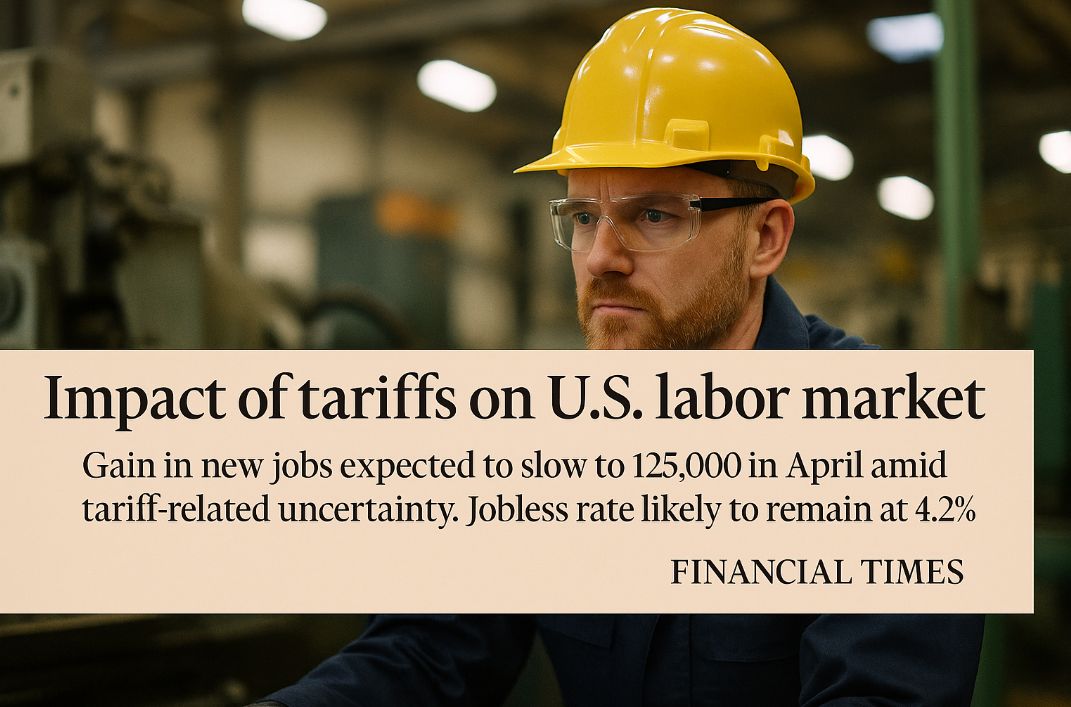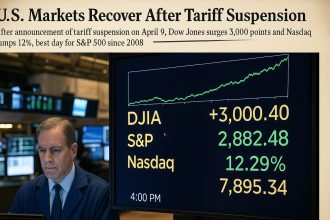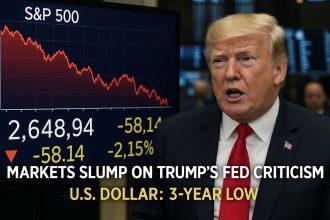Have you ever wondered how a single policy decision can ripple through the lives of millions? As I sit down to write this, I’m thinking about the countless Americans waking up each day, wondering how the latest economic headlines will affect their jobs, their families, and their futures. The U.S. labor market has long been a beacon of strength, but recent developments—especially the introduction of sweeping tariffs—are casting a shadow of uncertainty over its resilience. Let’s dive into what’s happening, why it matters, and what it might mean for you and me.
The Current State of the U.S. Labor Market
The U.S. economy is at a crossroads. According to forecasts from the Financial Times, the labor market is expected to add just 125,000 jobs in April 2025—a sharp slowdown from the 228,000 jobs added in March. The unemployment rate, currently at 4.2%, is projected to hold steady, but that stability feels fragile when you consider the broader economic picture. These numbers reflect a labor market that’s still robust but increasingly vulnerable to external pressures, particularly tariffs.
Why the slowdown? President Trump’s decision to impose sweeping import tariffs, including a minimum 10% on all trading partners and higher rates on key competitors like China and the EU, has sent shockwaves through global markets. These tariffs, designed to protect domestic industries, are sparking fears of a trade war, disrupting supply chains, and raising prices for consumers and businesses alike. The result? Businesses are hesitating to hire, and some are even considering layoffs to offset rising costs.
How Tariffs Are Reshaping the Economy
Tariffs are taxes on imported goods, meant to make foreign products more expensive and encourage consumers to buy American. Sounds simple, right? But the reality is messier. Tariffs don’t just affect importers—they ripple through the economy, hitting manufacturers who rely on foreign parts, retailers who stock imported goods, and ultimately, consumers who face higher prices. When prices go up, businesses often cut back on hiring or reduce staff to stay afloat.
The International Monetary Fund has already sounded the alarm. In its latest World Economic Outlook, the IMF slashed its 2025 growth forecast for the U.S. to 1.8%, down from 2.7% in January. Globally, growth is expected to slow to 2.8% this year, a sharp downgrade from earlier predictions. The IMF’s chief economist, Pierre-Olivier Gourinchas, noted that the April 2 tariff announcement forced a rapid revision of projections, compressing a two-month process into just 10 days. This underscores the magnitude of the tariffs’ impact—not just on the U.S., but on the global economy.
Economists are also warning that the effects of these tariffs could be felt as soon as April’s employment report. A Reuters poll suggests the unemployment rate could average 4.4% this year and 4.6% next year if current trends continue. That’s a far cry from the sub-4% rates we’ve seen in recent years, signaling potential challenges ahead for workers and job seekers.
Personal Stories from the Frontlines
To really understand what’s at stake, I reached out to a few friends in different industries. Sarah, who runs a small manufacturing business in Ohio, shared her frustration: “The uncertainty is killing us. We’re hesitant to hire new staff because we don’t know what the next few months will bring. Tariffs are making our raw materials more expensive, and we’re passing those costs on to customers—but only so much before they stop buying.” Her story is a stark reminder that behind every economic statistic is a real person grappling with tough decisions.
Then there’s Mike, who works in retail. He told me foot traffic at his store has dropped noticeably since the tariffs were announced. “People are holding off on big purchases,” he said. “They’re waiting to see how things play out, and that’s hurting our bottom line. If this keeps up, we might have to cut back on hours or even let some people go.” These stories aren’t just anecdotes—they’re a window into the human cost of economic policy.
A Broader Economic Picture
Let’s zoom out. The U.S. economy is incredibly complex, and tariffs are just one piece of the puzzle—but they’re a big one. Beyond the IMF, other experts are raising red flags. Deloitte Insights now expects U.S. GDP growth to slow to 1.9% in 2025 and just 0.8% in 2026 if tariffs remain in place. J.P. Morgan echoes this, noting that the March jobs report, while strong, may be the “high-water mark” as tariffs begin to bite.
Tariffs are also fueling inflation. By making imports more expensive, they drive up prices across the board. The IMF projects U.S. inflation will stay stubbornly high at 4.3% this year, slowing the decline expected earlier. This is particularly tough on low-income families, who spend a larger share of their income on goods affected by tariffs, like clothing and electronics. The Budget Lab at Yale estimates that tariffs could cost the average household $3,800 in purchasing power in 2024 dollars, with lower-income households facing a disproportionate burden.
| Economic Impact | April 2 Tariffs Only | All 2025 Tariffs |
|---|---|---|
| U.S. Real GDP Growth (2025) | -0.5% lower | -0.9% lower |
| Long-run GDP Level | -0.4% smaller ($100B annually) | -0.6% smaller ($160B annually) |
| Consumer Price Increase | 1.3% | 2.3% |
| Household Cost (2024$) | $2,100 | $3,800 |
Navigating Uncertainty: A Tool for Turbulent Times
In times like these, staying informed and adaptable is crucial. I recently came across PocketOption, a trading platform that’s been gaining attention for its user-friendly interface and educational resources. Whether you’re a seasoned trader or just starting out, having access to tools that help you navigate volatile markets can make a big difference. PocketOption offers features designed to empower users to make informed decisions, which feels especially relevant given the economic uncertainty we’re facing. Check it out if you’re looking to stay ahead of the curve.
A Ray of Hope?
Despite the challenges, there’s reason for cautious optimism. The U.S. economy is resilient, and it’s weathered tough times before—think recessions, trade disputes, and even pandemics. If tariffs are resolved through negotiations, or if businesses find creative ways to adapt, we could see a recovery in job growth. Federal Reserve Chair Jerome Powell recently noted that the economic effects of tariffs will likely include “higher inflation and slower growth,” but he also emphasized the Fed’s commitment to stabilizing the economy through careful policy adjustments.
There’s also the possibility of exemptions or trade deals that could soften the blow. For instance, the Budget Lab at Yale notes that a 90-day suspension of some tariffs was announced on April 9, which could provide temporary relief. But for now, caution is the order of the day, and businesses and workers alike are bracing for impact.
Looking Ahead: What’s Next for the Labor Market?
So, where do we go from here? The expected job growth of 125,000 in April is a wake-up call, signaling that economic policies have real-world consequences. If this trend continues, we could see a period of stagnation or even contraction in the labor market. The unemployment rate, already at 4.2%, could creep higher, especially if businesses scale back hiring in response to rising costs.
But it’s not all doom and gloom. The U.S. has a knack for bouncing back, and history shows that smart policies and innovation can turn the tide. The key is finding a balance—policies that protect domestic industries without alienating global partners, and solutions that prioritize growth without sacrificing stability. For now, staying informed and engaged is the best way to navigate these uncertain times.
Final Thoughts
As I wrap this up, I’m struck by a mix of concern and hope. Concern because the road ahead looks bumpy, with tariffs threatening to slow job growth and raise prices. Hope because I know how resilient Americans are, from small business owners like Sarah to retail workers like Mike. Whether you’re a worker, a business owner, or just someone trying to make sense of it all, your voice matters. What do you think about tariffs and their impact on jobs? Are you feeling optimistic or worried about the future? Drop your thoughts in the comments—I’d love to hear from you.




